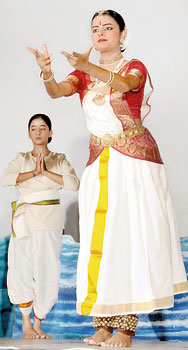‘The spirit of Swami Vivekananda’in song, word and dance
View(s):The Ramakrishna Hall was full and around 6.10 in the evening of May 4, Aarathi was taken by two dancers for Swami Vivekananda while a third rang the temple bell softly as the audience stood up in silence paying homage to the great Swami whose 150th birth anniversary, the Kalagam was celebrating

All was still and the curtain gently opened depicting the emerging dawn at Kanya Kumari – the tip of South India where a young man in sannyasin’s garb was sitting in deep meditation.
A dancer came from amongst the ashram students and danced to the words of the Mantram “Guru Brahma! Guru Vishnu! Guru Devo Maheswara: ….”
The compere’s words – “Born on the 12th of January 1863, Naren who later became Swami Vivekananda strode like a colossus on the Indian and international scene. He introduced Hinduism to the west and reawakened the Hindus of India from their slumber and servitude. He was born at a time when his country was under British rule and his people were politically suppressed, economically impoverished and socially divided. He carried the message of the Oneness of humanity and Hinduism’s acceptance of all religions as true,” introduced the story of the Swamiji.
The story goes back to the time when together with his peers he received the Sannyasin’s orange robes being initiated into sannyasam by Sri Ramakrishna himself. Soon after the ordination, Naren, had a calling to live for a time as a wandering monk. He left Kolkata and travelled far and wide and finally sat on the rock in the southern tip of India that today bears his name.
It was here that he received a vision of the future of one India and realized, that even though as a nation, India may have lost its individuality yet there was hope for his country and his fellow Hindus to arise and awake in keeping with Hindu spiritual traditions.
The compere told us that it was then that Swamiji resolved, “to dedicate himself to the service of India and to spread the message of the Vedanta. This could be made possible through the training of the young minds and the upliftment of the women and the masses.”
The Parliament of Religions
Swamiji was invited to participate at the World Parliament of Religions in Chicago in 1893 and the day he stood before the audience in Chicago at the Parliament of Religions unfurling the Hindu Dharma flag saying, “Sisters and Brothers of America,” he emanated a magnifying power that mesmerized the audience into pin-drop silence, only to rise to give him a standing ovation. “I bring greetings to the youngest of the nations on behalf of the most ancient order of monks in the world, the Vedic order of sannyasins, a religion which has taught the world both tolerance and universal acceptance. “We accept all religions as true,” he said quoting the Vedic sloka. He infused this spirit of tolerance and acceptance and its sense of universality into the Parliament as he received the resounding applause.
Swamiji’s vision of the future of India
Several girls came dancing, beating the drum singing, “Kottu murase! Arise! Awake…” One dancer depicted the Hindu prayer followed by the inspiring words, “Buddham saranam gachchaami! Dharmam saranam gachchaami! Sangam saranam gachchaami.” And the remaining dancers brought out the prayers of Islam and Christianity. “As the different streams having their sources in different places all mingle their water in the sea so, O Lord, the different paths which men take through different tendencies, various though they appear, crooked or straight, all lead to Thee!” The compere’s words floated through the air.
This was followed by the touching scene of Sri Saradha Devi in discussion with Swamiji and his colleagues. And in came a bevy of young dancers dancing and asking questions about the work that Swamiji and his colleagues are doing.
And the compere’s words:
“No peace and harmony could be brought about and no improvements could be effected in any society until and unless the women and the masses who form a greater part of the population are educated. If women, who according to Swamiji are the embodiments of the Divine Mother, are elevated then culture, freedom, peace and harmony will spread not only in the homes but also amongst humanity.”
The finale to the presentation was the singing of the “Mangalam,” a benediction itself where the senior dancers came dancing-in singing, “Mangalam! to the worthy son of Bharata Mata! The son who realized the importance of uplifting the woman and the masses through education – Mangalam! mangalam!
Follow @timesonlinelk
comments powered by Disqus


